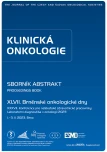The role of Schlafen 11 as a predictive biomarker in ovarian cancer patients treated with platinum-based chemotherapy – results of the pilot analysis
Authors:
J. Hausnerová 1; L. Ehrlichová 2; P. Ovesná 3; K. Matulová 1; J. Chlubnová 2; V. Weinberger 4; Markéta Bednaříková 2
Authors‘ workplace:
Ústav patologie LF MU a FN Brno
1; Interní hematologická a onkologická klinika LF MU a FN Brno
2; Institut biostatistiky a analýz, MU Brno
3; Gynekologicko-porodnická klinika LF MU a FN Brno
4
Published in:
Klin Onkol 2023; 36(Supplementum 1): 127-130
Category:
Article
doi:
https://doi.org/10.48095/ccko2023S127
Overview
Background: Schlafen 11 (SLFN11), a recently discovered nuclear protein, has been identified as a promising biomarker capable to predict the response to DNA damage-inducing agents across various cancer types. In this article, we present the results of the pilot SLFN11 immunohistochemical (IHC) analyses in ovarian cancer (OC) patients treated with platinum-based chemotherapy (P-CHT).
Materials and methods: The retrospective cohort of 61 ovarian cancer patients treated with primary P-CHT at University Hospital Brno in 2010–2021 was identified from the clinical database based on predefined criteria. The IHC analyses of SLFN11 expression were performed on tumor samples collected before P-CHT initiation using monoclonal antibody SLFN11 (D-2), sc-515071 (Santa Cruz Biotechnology, Texas, USA). The slides were evaluated for SLFN11 expression in tumor cells by H-score (total score = 1× weak + 2× mean + 3× strong positivity) and as a percentage of positivity of any intensity. Results: From the whole cohort of 61 patients, a total of 30 patients had P-resistant disease with a median platinum-free interval (TFIp) of 5 months; the interquartile range (IQR) was 2–10 and 31 patients had P-sensitive disease with median TFIp 43 months (IQR 26–81). The stage at diagnosis, histological type, and extent of surgical cytoreduction were equally distributed in both cohorts. Except for one patient in the P-sensitive cohort, all tumor samples were evaluable for IHC SLFN11 analyses. SLFN11 expression was generally low in the entire cohort (H-score 10, 10% positivity). Neither statistically significant differences in SLFN11 expression between P-resistant and P-sensitive disease, nor the correlation with main prognostic factors (stage at diagnosis, objective response to primary treatment, TFIp, overall survival) were observed.
Conclusion: With the methodology used in this pilot study, we failed to demonstrate any predictive or prognostic significance of the immunohistochemical SLFN11 evaluation in ovarian cancer patients treated with platinum-based chemotherapy.
Keywords:
immunohistochemistry – ovarian cancer – SLFN11 – predictive marker
Sources
1. Ballestrero A, Bedognetti D, Ferraioli D, et al. Report on the first SLFN11 monothematic workshop: from function to role as a biomarker in cancer. J Transl Med 2017; 15 (1): 1–99. doi: 10.1186/s12967-017-1296-3.
2. Shee K, Wells JD, Jiang A, Miller TW. Integrated pan-cancer gene expression and drug sensitivity analysis reveals SLFN11 mRNA as a solid tumor biomarker predictive of sensitivity to DNA-damaging chemotherapy. Christie E, ed. PLoS ONE 2019; 14 (11): e0224267. doi: 10.1371/journal.pone.0224267.
3. Zhang B, Ramkumar K, Cardnell RJ et al. A wake-up call for cancer DNA damage: the role of Schlafen 11 (SLFN11) across multiple cancers. Br J Cancer 2021; 125 (10): 1333–1340. doi: 10.1038/s41416-021-01476-w.
4. Zoppoli G, Regairaz M, Leo E, et al. Putative DNA/RNA helicase Schlafen-11 (SLFN11) sensitizes cancer cells to DNA-damaging agents. Proc Natl Acad Sci U S A 2012; 109 (37): 15030–15035. doi: 10.1073/pnas.1205943 109.
5. Barretina J, Caponigro G, Stransky N et al. The Cancer Cell Line Encyclopedia enables predictive modelling of anticancer drug sensitivity. Nature 2012; 483 (7391): 603–607. doi: 10.1038/nature11003.
6. Takashima T, Taniyama D, Sakamoto N, et al. Schlafen 11 predicts response to platinum-based chemotherapy in gastric cancers. Br J Cancer 2021; 125 (1): 65–77. doi: 10.1038/s41416-021-01364-3.
7. Taniyama D, Sakamoto N, Takashima T et al. Prognostic impact of Schlafen 11 in bladder cancer patients treated with platinum-based chemotherapy. Cancer Sci 2021; 113 (2): 784–795. doi: 10.1111/cas.15207.
8. Nogales V, Reinhold WC, Varma S et al. Epigenetic inactivation of the putative DNA/RNA helicase SLFN11 in human cancer confers resistance to platinum drugs. Oncotarget 2016; 7 (3): 3084–3097. doi: 10.18632/oncotarget.6413.
9. Winkler C, King M, Berthe J et al. SLFN11 captures cancer-immunity interactions associated with platinum sensitivity in high-grade serous ovarian cancer. JCI Insight 2021; 6 (18): e146098. doi: 10.1172/jci.insight.146 098.
10. Willis SE, Winkler C, Roudier MP et al. Retrospective analysis of Schlafen11 (SLFN11) to predict the outcomes to therapies affecting the DNA damage response. Br J Cancer 2021; 125 (12): 1666–1676. doi: 10.1038/s41416-021-01560-1.
11. Takashima T, Sakamoto N, Murai J et al. Immunohistochemical analysis of SLFN11 expression uncovers potential non-responders to DNA-damaging agents overlooked by tissue RNA-seq. Virchows Arch 2021; 478 (3): 569–579. doi: 10.1007/s00428-020-028 40-6.
Labels
Paediatric clinical oncology Surgery Clinical oncologyArticle was published in
Clinical Oncology

2023 Issue Supplementum 1
- Metamizole vs. Tramadol in Postoperative Analgesia
- Metamizole at a Glance and in Practice – Effective Non-Opioid Analgesic for All Ages
- Metamizole in the Treatment of Acute Postoperative Pain
- Possibilities of Using Metamizole in the Treatment of Acute Primary Headaches
- Spasmolytic Effect of Metamizole
Most read in this issue
- I. Onkologická prevence a screening
- X. Nežádoucí účinky protinádorové léčby a podpůrná léčba
- XIX. Nádory tlustého střeva a konečníku
- III. Follow-up, sledování onkologických pacientů
